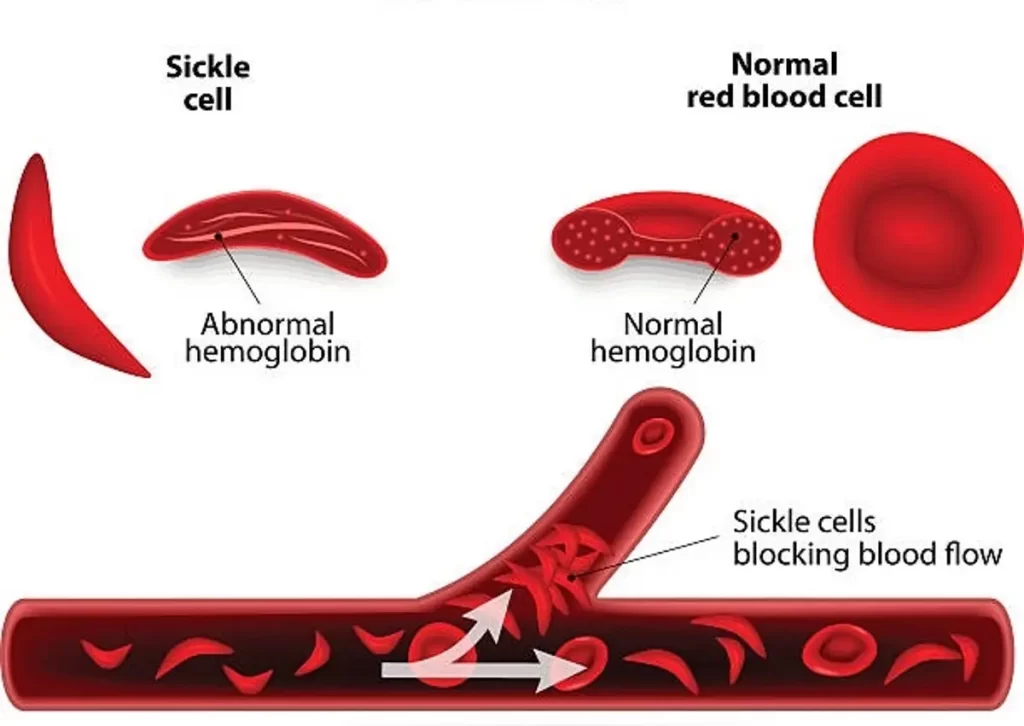SICKLE CELL DISEASE
Our commitment

Crédits photo: AFP
We dedicate a permanent section to sickle cell disease on our site because it is a public health problem that affects us closely. A disease that causes extreme suffering, that isolates and kills…in silence!
“I feel indescribable pain that is impossible to calm down because I have a severe form of the disease. Pain that cannot be described,” says Maguèye Ndiaye, president of the Senegalese Association for the Fight against Sickle Cell Disease, Sickle cell disease is the most prevalent genetic disease in the world, yet there is a serious lack of awareness.
At Humaniterre, we are convinced that ongoing communication and awareness-raising activities can help reduce the prevalence of this disease in Africa and throughout the world! A campaign that goes far beyond the celebration of this unique International Day for the Fight against Sickle Cell Disease (IDSAD), on June 19th of each year.
It would only take 3 generations to eliminate sickle cell disease from a family line!
However, we see that the opposite is happening, the disease is growing!
From 2010 to 2050, it is expected that the number of children born with sickle cell disease will increase by 30% worldwide.
On a global level, the numbers are alarming:
- 300,000,000 People carrying the sickle cell trait*
- 6,400,000 People with sickle cell disease
- 300,000 Children born each year with sickle cell disease
*People with sickle cell trait have a normal hemoglobin gene and a sickle cell hemoglobin gene.
People with sickle cell trait have two sickle cell hemoglobin genes and are very likely to express the symptoms of sickle cell disease.
According to Robert Hue, former French parliamentarian and president of the NGO Drep Afrique: “There is no awareness as there is with malaria. We forget about this disease because it is not contagious. It is not a disease like AIDS. However, it kills a lot. There are 15 million sickle cell patients in Africa, with a severe form of the disease and a very high mortality, it is responsible for more than 200,000 deaths per year.”
In 2017, the government of Côte d’Ivoire announced a prevalence rate* of 14% through the voice of the Minister of Women’s Protection of Children and Solidarity. The Lya Foundation (FLVD) stated in 2019 on the occasion of the celebration of World Sickle Cell Day, at the American Cultural Center: “In Côte d’Ivoire, the prevalence is 14% of the AS trait with 4% of major form and there are 6,000 cases detected each year at birth of which 60 to 70% die before the age of 5 years.
Other sources have also announced a rate of between 14 and 18% depending on the region; the north of Côte d’Ivoire being more affected.
Nevertheless, we remain very cautious about the prevalence rates in African countries. In addition to the inexistence or insufficiency of adequate infrastructures for the management of the disease, the high cost of drugs when they are available, there is a problem of updating or absence of statistical data on the disease.
“The studies that exist are only approximations. We have been talking about a prevalence rate of 8 to 10% for a very long time. No field study has been conducted to indicate the number of sickle cell patients in the country,” lamented Mr. Magueye Ndiaye, President of the Senegalese association for the fight against sickle cell disease.
These challenges are a reality for patients across the continent.
We believe that we will not be too much to bring through information, communication and awareness a little light on this chronic disease that affects the lives of millions of people around the world and particularly in Africa and in our country, Côte d’Ivoire. This is our commitment.
Sources:
BBC- Africa News programSickle cell disease in Africa: the challenges of providing better care for the millions of people affected – BBC News Africa
www.notaloneinsicklecell.com
The Global Impact of Sickle Cell Disease | NotAloneInSickleCell.com
Sickle Cell Disease – Drep.Afrique (drep-afrique.org)
www.abidjan.net APA agency – Sunday, June 11, 2017
